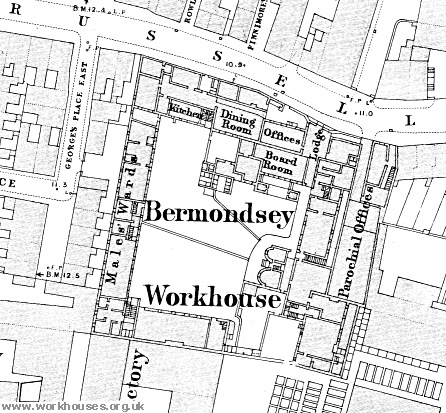Bermondsey (St Mary Magdalen), Surrey, London
Up to 1834
St Mary Magdalen, Bermondsey, was the subject of a report in An Account of Several Workhouses..., dated May 1729.
Salisbury Street, later renamed Wilson Grove, ran from Jamaica Road up towards the Thames.
In 1777, the workhouse could house 291 inmates.
In 1791, a new workhouse was erected at the south side of Russell Street (later renamed Tanner Street), to the south-east of what is now the site of London Bridge station. In 1832, there were 164 male inmates and 265 female. Males were employed in picking oakum and the females in slop-work. These sexes had separate quarters but shared an outdoor yard. The children, then numbering 232, were in a separate establishment at Merton and occupied in weaving, shoemaking and making clothing.
After 1834
The Bermondsey Poor Law Parish was formed on 21st March, 1836, comprising the single parish of St Mary Magdalen. Its operation was overseen by an elected Board of Guardians, 18 in number. The population falling within the Union at the 1831 census had been 29,741. The average annual poor-rate expenditure for the period 1833-35 had been £16,861.
The Bermondsey Guardians continued using the existing Russell Street parish workhouse and additions were made to the buildings in 1844. The workhouse location and layout is shown on the 1872 map below. The buildings roughly formed a square with the Russell Street side at the north containing the workhouse entrance, porter's lodge, dining-hall, kitchens, and guardians' board-room. Male inmates were accommodated along the west side of the building.

Bermondsey Russell Street workhouse site, 1875.
In 1865, Bermondsey was the subject of one of a series of articles in the medical journal The Lancet investigating conditions in London workhouse infirmaries. The report made a number of serious criticisms about the establishment:
- The workhouse site lay below the level of the Thames high-water mark and was often flooded, with water standing two feet deep in the basement.
- The infirm wards were a "fever-nest" and likely to foster epidemics.
- The sanitary arrangements of the infirm department were "scandalously bad" — two of the wards were very dirty, with their occupants "herding together in a miserable manner ... their watercloset and urinal (abutting on the deadhouse) stink so offensively as to poison the whole atmosphere of their airing-court."
- All the nursing was carried out by twenty-two pauper inmates, who received an improved diet, and, in some cases, a special dress.
- The medical officer was required to look after a parish district in addition to his workhouse duties, and also to pay for pay for all drugs from his salary.
- The accommodation for tramps was insufficient and that which did exist was "not fit for a dog". The beds consisted of bunks, or long orange-boxes, with a wooden log for a pillow, a blanket and rug to cover the sleeper, and not even a bit of straw for him to lie on.
- Children received inadequate amounts of milk in their diets.
Further details of the Lancet inspection are in the full report.
In 1868, the recently formed Metropolitan Asylums Board set up six new Sick Asylum Districts for the purposes of providing hospital care for the poor on separate sites from workhouses. One of the new Districts, named Rotherhithe, comprised the St Olave Union and the parishes of St Mary, Rotherhithe and St Mary Magdalen, Bermondsey. However, the new hospital required by the new scheme was felt to be too expensive and, instead, the Rotherhithe Sick Asylum District was reconstituted as an enlarged St Olave Poor Law Union.
The expanded union acquired the existing workhouses from Bermondsey at Tanner Street, and from Rotherhithe at Lower Road, the latter being redeployed to provide the separate hospital accommodation that was now required. The Tanner Road workhouse continued in use until 1922. After its closure, the building became a laundry. It was demolished in 1928 and the site cleared to create the Tanner Street recreation ground.
The St Olave Union was renamed the Parish of Bermondsey in 1904.
Staff
Inmates
Records
Note: many repositories impose a closure period of up to 100 years for records identifying individuals. Before travelling a long distance, always check that the records you want to consult will be available.
-
The
Ancestry UK
website has two collections of London workhouse records (both name searchable):
- Westminster workhouse records are available on FindMyPast, .
- London Metropolitan Archives, 40 Northampton Road, London EC1R OHB. Holdings for Tanner Street workhouse include: Births (1836-68); Deaths (1836-70, 1877-1914, 1916-20). Other holdings include: Guardians' minute books (1836-1870, 1904-30); Financial records (1836-1930); Staff records (1866-1930); etc.
Bibliography
- Higginbotham, Peter Workhouses of London and the South East (2019)
- Adams, J and Coll, G (1999) The History of Shirley Oaks Children's Home (London: Deptford Forum Publishing).
Links
Unless otherwise indicated, this page () is copyright Peter Higginbotham. Contents may not be reproduced without permission.


